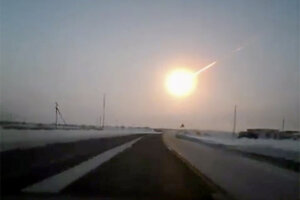Russian meteorite: Not the first strange event in the skies of Siberia
Science writer Surendra Verma looks back at the 'Tunguska event,' a mysterious occurrence in Siberia in 1908 which, like the 2013 meteorite, caused injuries and damage when the sky exploded.

A meteor streaks across the sky of Russia’s Ural Mountains on Feb. 15, 2013.
Nasha gazeta/www.ng.kz/AP
Last Friday brought quite the sky show to the Ural Mountains when the apparent explosion of a meteorite spawned tremendous sonic booms, bright flashes of light and hundreds of injuries. But this wasn't the first time chaos rained down from above in the huge chunk of North Asia known as Siberia.
Back on June 30, 1908, something in the sky above Siberia exploded, stunning people who lived dozens of miles away and leaving a scar across the landscape that exists to this day.
Surendra Verma, a science journalist and author based in Melbourne, Australia, wrote about the so-called "Tunguska event" in his 2005 book "The Tunguska Fireball: Solving One of the Great Mysteries of the 20th Century."
In an interview, Verma told me about the theories regarding the Siberian explosion of 1908 (including a wacky one featuring a volcanic eruption and extraterrestrials), his thoughts on what actually happened (sorry, no aliens involved) and the reason why this all matters to us today.
Q: What exactly happened on that day in 1908 in Siberia?
A: An explosion flattened a Siberian forest bigger than metropolitan New York, stripping tens of millions of ancient trees of leaves and branches, leaving them bare like poles and scattering them like matchsticks. A dark mushroom cloud of dust rose to a height of 50 miles over the area, and a black rain of debris and dirt followed.
The explosion lasted only a few seconds, but it was so powerful that it could be compared only with an atomic bomb – 1,000 Hiroshima atomic bombs.
The explosion was even registered by an earthquake measuring station 2,485 miles away in St. Petersburg. Earthquake tremors were also recorded by more distant stations around the world. But at that time no one knew the cause of these tremors.
Q: How far did this happen from inhabited areas?
A: The explosion site was then so remote that it was not even accessible to local inhabitants, the Tungus people. The nearest witnesses to the explosion were at Vanavara, a small trading station some 40 miles from the explosion site.
Several miles north of Vanavara, dozens of nomads and herdsmen were thrown into the air and bruised. An elderly man hit a tree and broke his arm. Another elderly man died of fright. Thousands of reindeer belonging to four separate herds were killed as the pines and cedars around them blazed.
Q: How have theories about what happened evolved over time?
A: In 1908, Russia was a country caught in political unrest and social upheaval. Nothing was [studied] until 1927 when a Soviet scientist, Leonid Kulik, visited the explosion site. After three expeditions to the site, Kulik came to the conclusion that the Tunguska event was caused by a meteorite.
Since Kulik’s death in 1942, numerous scientific expeditions have been conducted to the explosion site, but no crater and no meteorite material from outer space has yet been found.
Q: What if it wasn't a meteorite?
A: The question fascinates scientists and science fiction writers. There are nearly 100 theories.
The lineup of suspects includes a comet, a mini-black hole, an asteroid, a rock of antimatter or a methane gas blast from below. More imaginative explanations include an alien spacecraft that exploded in mid-air and an experiment on a "death ray" which got out of hand.
My favorite theory is that the famous Krakatoa volcanic eruption in August 1883 generated strong radio waves, which were received 11 years later at the star 61 Cygni, 11 light-years away from us.
The Cygnian scientists misread the signal as greetings from a distant civilization and decided to send a return message by laser. Unfortunately, the well-meaning scientists misjudged the Earth’s distance and fired a powerful beam that zapped Tunguska. The "extra strong" Cygnian message was all Greek to the local Siberian people; they did not have the required technology to read their greeting card from the stars.
Q: What do you think happened?
A: I believe – and overwhelming data supports my belief – that the Tunguska explosion was caused by a asteroid that vaporized 3 to 6 miles above Tunguska. The resulting fine debris and gases then dispersed over wide areas in the atmosphere.
Q: This is the "so what" question: So what? Why does this strange event matter to us today?
The Tunguska event matters because the number of victims could have been hundreds of thousands if it had happened over Europe instead of the desolate region of Tunguksa.
Scientists expect an event of this magnitude to occur once every 100 years. And we must not forget that it was an asteroid that killed the dinosaurs 65 million years ago.
And by comparison, the Russian meteor that exploded [last week] about 15 miles above the Earth packed energy equivalent to only 30 Hiroshima atomic bombs as compared to the 1,000 Hiroshima atomic bombs of the Tunguska event.
Q: Are there possible connections between 1908 and the event last week? Or is it purely a coincidence that these things both happened in Siberia?
A: It's pure chance. Incidentally, the 2013 meteor blast was 3,000 miles west of the Tunguska blast.
Q: If all this worries me, should I go outside with an umbrella? Build a meteorite-proof building? Move to Mars? Or just stop worrying and learn to love the asteroid or meteor or whatever?
A: Don’t worry. Scientists are exploring ways of nudging, pushing, crushing, covering, nuking or burning rogue large space rocks that may threaten good readers of The Christian Science Monitor.
Until then, the best strategy is to work on early warning systems.
Randy Dotinga is a Monitor contributor.

